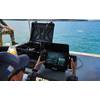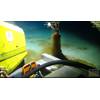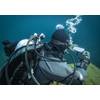New Satellite Technology Boosts Glacier Research
Researchers are developing a unique radar, which could allow a view of Earth's ice sheets
Bremerhaven, November 4, 2016. Scientists from the Alfred Wegener Institute are developing with experts from the German Aerospace Centre (DLR) a new satellite measurement method for the observation from space of the large ice masses of Greenland and the Antarctic. "Tandem L" is the name of a new satellite radar system, Which launched in the year 2022 Could Provide urgently needed data Concerning the shrinkage of the ice sheets in Both hemispheres. Concerning the construction of the radar and the launch of the satellite mission of the same name, the Science Council is to advise the Federal Ministry of Education and Research (BMBF) at the end of November as part of a review procedure.
"Extreme" is the word glaciologists now use to describe the extent of the annual summer melt on the surface of the Greenland ice sheet. This year, the scientists Observed, love especially in the north-east of Greenland, a widespread network of lakes and streams supraglacial on the ice sheet. Their water masses give cause for concern, above all for one reason: The melt water almost always makes its way through the ice sheet. At the ice base this water acts like a lubricant. It Increases the speed at Which the glaciers move. The result: Larger ice masses slip into the ocean; the sea level rises to a greater extent.
In order to be able to investigate the effects of surface melt on the glaciers and ice sheets of the world more profoundly and, above all, in large areas, scientists from the Alfred Wegener Institute havebeen assisting experts from the German Aerospace Centre over the past four years to create a new, satellite-based radar concept. This Detects the changes in the ice sheets for the first time using a tomographic method and, for example, makes the penetration of the melt water visible.
"The new tandem L radar Operates in the so-called L-band range. It Emits radio waves with a wavelength of 24 centimètres, Which in contrast to the previous satellite technology penetrate up to 100 meters deep in ice and snow. THUS, glaciologists would have the first opportunity to extensively screen the topmost ice layer of the glaciers and ice sheets from space and to map Their inner structure. in addition, we can therefore measure the changes in the glacier surface with tandem L ", says Professor Angelika Humbert, Head of the Glaciology Section at the Alfred Wegener Institute, Helmholtz Centre for Polar and Marine Research (AWI).
For the tandem-L mission, she and her team had INITIALLY Analysed data from the already operating satellites TerraSAR-X and tanDEM-X. On the basis of this, theywere able to develop methods of analysis and filtration That Could be used to understand the origin of the structures in the tandem-L images and to use the data for ice modeling.
to date, glaciologists have used aircraft or satellite-based altimeters to measure the topography of the ice surface in Greenland and the Antarctic and to calculate the ice losses of ice sheets by Means of the differences in altitude. Altimeter scan the surface with the aid of lasers or radar. It is important did the waves Emitted by the satellites do not penetrate the ice surface. The new tandem L system, on the other hand, wants to look deep into the ice and allow scientists to gain completely Call new insights with its high-resolution L-band data.
The satellite mission tandem L besteht of two satellites, each of Which is equipped with at L-band radar and are to orbit around the Earth in formation at at altitude of 760 kilometers. The radars scan the Earth's surface with a strip 175 to 350 kilometers wide. "Tandem-L will not only Provide us with important ice information so but receive urgently needed data on global forest biomass, soil moisture and ocean currents," says the scientific coordinator of the satellite mission Professor Irena Hajnsek from the Microwaves and Radar Institute at DLR.
at the beginning of this year, the BMBF launched on assessment procedure for the development of a roadmap for research infrastructures in Germany. Within the scope of this, the Scientific Council meets at the end of this month and, among other things, advises on the Tandem-L mission. . The results of the assessment are expected for mid-2017
















 February 2024
February 2024



